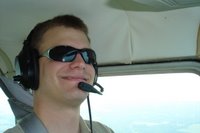Solo Cross Country

 Still catching up with my flying logs...On September 7th, the weather worked out just right for my first solo cross-country. Well, it wasn't my FIRST solo cross-country--I had been to 10G, VTA, PHD by myself already--but this would be my first cross-country of more than 50 miles from my home base (I40). For this trip, I thought about it and thought about it, and wanted to have something significant, but in the end, I just settled on KMRT (Marysville, OH). My flight path would be over some familiar terrain to help me avoid getting lost...not that you can really get lost with two VOR radios and a GPS onboard, but hey...that stuff can happen.
Still catching up with my flying logs...On September 7th, the weather worked out just right for my first solo cross-country. Well, it wasn't my FIRST solo cross-country--I had been to 10G, VTA, PHD by myself already--but this would be my first cross-country of more than 50 miles from my home base (I40). For this trip, I thought about it and thought about it, and wanted to have something significant, but in the end, I just settled on KMRT (Marysville, OH). My flight path would be over some familiar terrain to help me avoid getting lost...not that you can really get lost with two VOR radios and a GPS onboard, but hey...that stuff can happen. The flight out to KMRT was no problem. I considered calling CMH for flight following, but it was a fairly busy day on the approach frequency and I didn't want to be a burden on the controllers. Plus, I wanted to be able to do a little sight seeing if necessary. Landing in at KMRT was great, so I went around and did another one. With those two under my belt, I headed back to I40. In the photo below, you can see me crossing I-71 just about Polaris, near Delaware/Sudbury exits. There are a lot of golf courses on the North side of Columbus!

The flight back was uneventful, except for the fact that the fuel gauges worked the entire way back. Go figure.
Some clouds started to pop up at about 4000ft, so I dropped down to about 3000ft to duck below them and maintain my 500ft separation. You can see how purty some of them were - it was starting to get fairly convective by the time I landed at I40, so I was glad to put the airplane in the hangar for the remainder of the day. This day's flying got me up to 40hrs total time, with 19.4hrs PIC. I'm getting closer! Another 10 hours and I'm getting my checkride!
